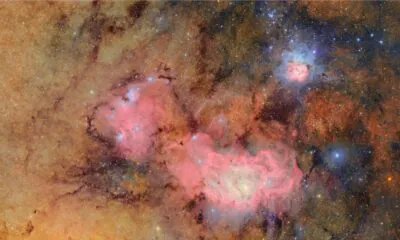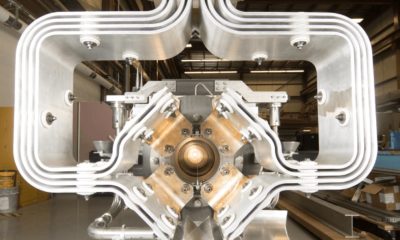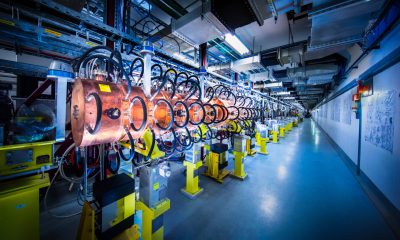航空宇宙産業
KAGRA: Japan’s Cryogenic Gravitational-Wave Detector
Securities.ioは厳格な編集基準を維持しており、レビューされたリンクから報酬を受け取る場合があります。当社は登録投資顧問ではなく、これは投資アドバイスではありません。 アフィリエイト開示.

How KAGRA Detects Gravitational Waves
The history of astronomy is closely tied to the progress of telescopes, which have progressively revealed more of the Universe to us. It began with the primitive telescope of Galileo and other pioneers, and continues to this day.
As time passes, more and more ways of detecting stellar activity have been deployed beyond the visible light spectrum.
私たちは、次のような新しい望遠鏡の大規模プロジェクトをいくつか取り上げてきました。
- DKIST、世界で最も強力な太陽望遠鏡。
- ジェイムズウェッブ宇宙望遠鏡地球から何百万マイルも離れたところにあります。
- ヴェラ・C・ルビン天文台一度に全天を観測する調査望遠鏡。
- SKAO (Square Kilometre Array Observatory)電波スペクトルで空を研究します。
- DUNE(深部地下ニュートリノ実験)捉えにくいニュートリノを検出します。
Another new type of astronomy is emerging, one that studies the sky in an entirely novel fashion: instead of light and various wavelengths of electromagnetic waves, it measures gravitational waves.
Only theoretical until relatively recently, now gravitational waves are a proven phenomenon. We previously covered one such “gravity telescope” with the レーザー干渉計重力波天文台 (LIGO)。
Another one is the Japanese project Kamioka Gravitational Wave Detector (KAGRA). Taking a different approach from LIGO’s large-scale, multi-site strategy, KAGRA instead focuses on ultra-high precision measurements using cryogenic mirrors to reduce interference.
From Einstein’s Theory to Gravitational Waves
重力は、電磁力や原子レベルで核力を駆動する力のように、宇宙の基本的な力の「単なる」ひとつであると長い間信じられてきた。
しかし20年代の変わり目にth 19 世紀、アインシュタインの相対性理論は重力を時空の曲率として説明しました。
彼の理論は、星のような非常に大きな物体に対する重力の働きを正確に説明しただけでなく、中性子星やブラックホールなど、当時まだ発見されていなかった多くの宇宙現象を予測しました。
Another prediction was the existence of gravitational waves, causing space to stretch and squeeze like ripples propagating on the surface of a lake.
Instead, a gravitational wave occurs when the fabric of space-time itself waves or vibrates.
So, gravitational waves are essentially making a specific segment of the universe stretch or contract, making a given distance longer or shorter when they pass by.
Some astronomical events would be likely massive enough to generate gravitational waves strong enough to be measured, like, for example, the collision of two black holes into each other.
However, no matter how powerful such a phenomenon is in absolute terms, the massive distance between Earth and its source, and the difficulty of trying to measure space-time itself, mean that an ultra-sensitive instrument needs to be designed to detect these events.
By the time the gravitational waves reach Earth, millions or billions of light-years away, they are 数千億 倍小さくなります。
So you need highly precise measurements, as the amount of space-time wobbling the gravitational waves generated is going to be 10,000x smaller than the nucleus of an atom!
干渉計が重力波を検出する仕組み
The first indirect evidence of gravitational waves was obtained through the study of a binary pulsar’s orbit. The orbital decay energy loss matched the predicted energy that would be lost to the generation of gravitational waves, この発見を担当した科学者は1993年のノーベル物理学賞を受賞した。.

出典: ノーベル賞
直接測定には、干渉計を用いた別の種類の証明が必要でした。干渉計の基本的な考え方は、光線間の相互作用を利用することです。2つの光波が同じ波長を持つ場合、それらは重なり合い、暗い点と明るい点のパターンを作り出します。
But if something changes the distance traveled by these wavelengths, like a gravitational wave, the disturbance can be measured.
重力波による時空の膨張と収縮により、干渉計の一方のアームももう一方のアームよりも大きく膨張したり収縮したりするため、重力波の検出および測定可能な影響が生じます。
Inside KAGRA: Design and Location
Interferometer Layout (3-km Arms)
Like other interferometers, the base concept of KAGRA is to use a tube several kilometers long, where a laser is fired. That laser beam is then split into two along perpendicular paths.

出典: ノーベル賞
Both beams are then reflected back after hitting a mirror. Normally, each laser beam should cancel each other out, resulting in no light detected.
しかし、重力波によって片方の腕がもう片方よりも収縮または伸長すると、レーザー光線間の干渉が止まり、光信号が検出されます。
2015年、米国立科学財団レーザー干渉計重力波観測所(NSF LIGO)は、地球から1.3億光年離れたブラックホールの衝突によって発生した波の検出を確認した。
この画期的な作品は 物理学者のライナー・ワイス、バリー・バリッシュ、キップ・ソーンが2017年のノーベル物理学賞を受賞した。.
What Makes KAGRA Unique (Underground & Cryogenic)
一方、 LIGO was the first to detect gravitational waves, KAGRA might be the next step in this field of science.
The reason is that KAGRA is built underground, and thanks to an upgrade from its initial setups, when it was still called the Large Scale Cryogenic Gravitational Wave Telescope (LCGT), KAGRA is using test-mass mirrors that are cooled to cryogenic temperatures.
The cold temperature allows for much more precise measurement and will be a key feature of future interferometry projects, like the アインシュタイン望遠鏡 (launch planned for 2035) or the コズミック・エクスプローラー (launch planned for the 2040s).
KAGRA Technical Specifications
KAGRA is designed to observe gravitational waves from neutron-star binaries out to ~150 Mpc (~489 million light-years), depending on detector sensitivity during a given observing run.
The main body of KAGRA is made of a pair of 3 km-long (1.8 miles) arm tunnels meeting at a 90° angle in the horizontal plane. It is the scaled-up version of the 100-meter-long prototype called Prototype Cryogenic Detector (CLIO).
The installation is located 200 m (656 feet) underground, a design that significantly reduces the noise from seismic waves on the Earth’s surface. Building underground, therefore, solves most of the low-frequency interference impacting surface interferometer designs, like with LIGO.
Despite the region being prone to earthquakes, this specific site is rather shielded, thanks to unique geological features.
“Earthquake waves are weakened when they propagate across the Tateyama mountain range, standing northeast of the KAGRA site.
This is because the low-density ground is distributed at an altitude of approximately 5 km acts as a cushion.”
KAGRA is part of the Kamioka Observatory, located in the Kamioka mine, a laboratory that specializes in the detection of neutrinos, dark matter, and gravitational waves.
The Kamioka Observatory is notable for including スーパーカミオカンデ, a neutrino detector that made history by detecting the first evidence of neutrino oscillation in 1998.

出典: MDPI
KAGRA was completed on 4 October 2019, after 9 years of construction. Its systems were further upgraded in 2021-2022, after the first observations started in February 2020 were interrupted by the COVID pandemic.
The KAGRA collaboration is composed of more than 360 individuals from more than 90 institutions. KAGRA itself is operated by the University of Tokyo’s Institute for Cosmic Ray Research (ICRR) with contributions from the National Astronomical Observatory of Japan (NAOJ) and the High Energy Accelerator Research Organization (KEK).
スワイプしてスクロール→
| 検出器 | 腕の長さ | Site | 温度 | ミラー素材 | 主な差別化要因 |
|---|---|---|---|---|---|
| KAGRA (Japan) | 3キロ | Underground (~200 m) | ~20 K (cryogenic) | Sapphire (~23 kg) | Cryogenic mirrors & reduced seismic noise |
| LIGO (USA) | 4 km (Hanford/Livingston) | 表面 | 室温 | Fused silica (~40 kg) | First direct detections; high optical power |
| Virgo (Italy) | 3キロ | 表面 | 室温 | 石英ガラス | Advanced seismic isolation (superattenuators) |
| Einstein Telescope (EU, planned) | 10 km (triangular) | 地下 | 123 K / 10–20 K (dual) | Silicon (planned) | Third-gen sensitivity; dual-band design |
| Cosmic Explorer (US, planned) | ~40 km (concept) | Surface/greenfield | 123 K (concept) | Silicon (concept) | Orders-of-magnitude reach gain |
Vacuum Conditions
The requirement for the laser beams to go without any interference extends to the ambient air, with a strong vacuum and no dust.
The facility follows ISO class 6 cleanroom standards, with ISO 1 cleanroom standards for the laser room and the booths for the cryostats. The walls of the underground facility are coated with anti-dust paint.
An ultra-high vacuum of the order 0.0000007 Pa is achieved through electrochemical buffing.
Meanwhile, the ceilings are covered with plastic sheets to protect the facility from underground water drops.
Laser System & Low-Latency Data
A very powerful and stable laser is needed to work over the 3-kilometer distance and react strongly enough to the gravitational wave.
KAGRA utilizes a 400 mW Nd:YAG NPRO laser, amplified by a commercial fiber amplifier, which yields an output power of 40 W. The laser light within the Fabry-Pérot cavities of the interferometer can reach powers up to a value of 400 kW.
Data are first sent over a 7-km fiber to a nearby analysis building in ~1 second, then to ICRR (Kashiwa) in ~3–10 seconds. Calibrated low-latency data are then shared with the LVK network: typically reaching LIGO sites in ~7–8 seconds and Virgo in ~12–15 seconds.
Cryogenic Mirrors
The mirrors used are made of sapphire, with a diameter and thickness of 22 and 15 cm (9 and 6 inches), and a mass of 23 kg (50 pounds). The high-reflective surface of the mirror is coated with 22-40 layers of silica (SiO₂) and tantala (Ta₂O₅).

出典: カリフォルニア工科大学
The sapphire mirrors are suspended by 35cm-long (14 inches) four sapphire fibers attached with a gallium foil.
This setup allows for the sapphire suspension fiber to transfer 1W of heat from the mirror, which determines the limit of the laser power input before heating interferes with the measurement.

出典: カリフォルニア工科大学
The cryogenic system to cool the mirror uses 99.9999% purity aluminum heat links, each made of a strand of 49 wires, each of 0.15 mm in diameter (6 thousandths of an inch). The mirrors themselves are kept at 20 K (-253 °C / -424 °F).
A series of vibration-absorbing systems keeps the mirror from moving due to the cooling system working.

出典: PTEP
Another vibration-absorbing device protects the mirrors and the laser from seismic vibrations, using an inverted pendulum for horizontal isolation and a geometrical anti-spring filter.

出典: PTEP
ユニークな課題
The location and design of KAGRA make it potentially the most powerful gravitational wave detector in the world. It is, however, not without its own set of challenges.
For example, there is an underground spring in the area, which is drained by a pipe at a volume of 1,200 tons of spring water per hour. This creates noise that needs to be neutralized to not interfere with measurements.
Even in a strong vacuum, some molecules of water persist in the air. They tend to form ice at the surface of the mirror due to the ultra-cold conditions. So keeping the cryogenic duct-shields even colder, and regular defrosting are required.
The sapphire mirrors were also not manufactured perfectly, with polarization of the laser light displaying some errors and reducing the efficiency of the entire facility. Further research is ongoing to manage to create a perfectly homogeneous sapphire crystal in terms of birefringence.
The cryo-cooler is also prone to failure, with a lifetime of the rotary valve of only 3000 h, creating a mean time between failures of only 15 days. This was acceptable for early tests, but making longer observations in the future will require this problem to be fixed as well.
KAGRA’s Potential
Due to the upgrade during the pandemic and technical issues still needing fixing, KAGRA has not reached its full potential yet.
It has, however, started to collaborate with LIGO and VIRGO, leading to the detection of more than 200 重力波 既に。
The latest signal, which occurred on March 19, 2025, is over 99% likely to originate from the merger of two black holes.
“The scientific community is intensely engaged in the in-depth analysis of this vast amount of new data that the detectors have provided us over the past year and a half.
We will gather new information about black holes, neutron stars, and the evolution of our Universe.”
These preliminary results already demonstrate that the mergers of two black holes are far more frequent than events involving neutron stars, which are much rarer.
This could, however, maybe be linked to the sensitivity of the detector used, and an upgraded KAGRA might detect more or less powerful interactions between neutron stars.
More accurate measurements will also help detect more distant stellar events or better understand the details of what happens when two black holes collide and merge into each other.
まとめ:
KAGRA is the latest, and likely not the last, of interferometers giving us our first insight into gravitational waves. Not only will these data prove useful for astronomers, but they should open new possibilities for physicists to understand gravity, still the least understood of the four fundamental forces.
A project like this might at first glance appear purely academic. This is rarely the case, even if the direct applications are hard to imagine initially. For example, Einstein’s theory of relativity is today routinely used to calibrate GPS satellites, an everyday application that was difficult to foresee in 1919.
Similarly, KAGRA is pushing scientists to invent ever more precise mirrors, stabilization and cooling systems, and lasers, demanding world-class levels of engineering. These innovations are likely to bear fruit in technologies well beyond astronomy, including advanced computing and space systems.
先端光学への投資
コーニングインコーポレイティッド
コーニングインコーポレイティッド (GLW -1.3%)
望遠鏡によって高度なガラスの精密製造の可能性が広がるにつれ、自動車、半導体、AI、防衛、バイオテクノロジー、ヘルスケアなど、さまざまな分野で多くの産業的可能性も開かれます。 先端光学市場は310億ドルの市場であり、9.2年まで年平均成長率2032%で成長すると予想されている。.
コーニングは170年の歴史を持つガラスおよび光学部品メーカーです。創業以来、トーマス・エジソンの電球用ガラス電球、低損失光ファイバー、触媒コンバーターを実現するセルラー基板、そしてモバイル機器用カバーガラスなど、数々の製品を製造してきました。

出典: コーニング
Today, the company is focused on core technologies related to manufacturing glass and ceramics, as well as optical physics technologies, which share common manufacturing processes and end markets.

出典: コーニング
この技術の相互連携により、同社は様々な製品ライン間で共通の製造、研究、エンジニアリング能力を共有することが可能になっています。52,000人以上の従業員、世界中に77以上の製造拠点、10以上の研究開発施設を擁する同社は、ニッチ市場における大手企業です。

出典: コーニング
同社は、AIやデータセンター構築(光ファイバー)のブーム、およびスクリーンやバイオテクノロジーにおける特殊ガラスの全体的な消費の恩恵を受けています。
コーニングは米国売上高の90%が米国産製品によるものであるため、関税の影響はそれほど大きくないと考えられます。中国での売上高のうち、米国工場で生産されたものはごくわずかで、中国での売上高の80%は中国で生産されています。
コーニングは太陽光パネル市場に参入し、戦略的にコントロールしているため、関税はプラスに働く可能性もある。 ヘムロックソーラー, to produce US-made panels, as Asian solar panels (not just Chinese) are being submitted to quadruple-digit tariffs. 80% of the capacity has already been secured by customers’ commitments.
同社にとって太陽光発電は大きな意味を持つ。シリコンは同社の中核的な製造技術を担っており、同社は超純粋シリコン(純度60%)を含むポリシリコンを99.9999999999年間生産しており、現在は米国から100%輸入しているシリコンウエハーの生産を開始している。

出典: コーニング
同社はまた、曲げられるガラス、AR、炭素回収など、ガラスやセラミックに関する専門知識が確固たる優位性をもたらす可能性のある他の先進技術にも注目している。

出典: コーニング
Overall, Corning is a highly technical company with localized manufacturing that should not be affected by deglobalization. It also embraces new markets that match its core competencies, notably solar and optical communication / AI infrastructure. This makes it both a relatively conservative company, only digging deeper into its niche, but also a potential growth stock in high-tech markets.













